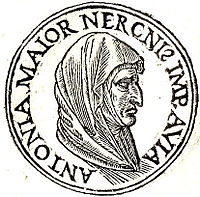Antonia the Elder
| Roman imperial dynasties | ||
|---|---|---|
| Julio-Claudian dynasty | ||
| Chronology | ||
|
27 BC – AD 14 |
||
|
AD 14–37 |
||
|
AD 37–41 |
||
|
AD 41–54 |
||
|
AD 54–68 |
||
|
||

Antonia Major (in Latin: Antonia Maior, PIR2 A 884) (b. August/September 39 BC), also known as Antonia the Elder, was a daughter of Mark Antony and Octavia Minor and a relative of the first Roman Emperors of the Julio-Claudian dynasty. She was a niece of the Emperor Augustus, step cousin of the Emperor Tiberius, paternal great-aunt of the Emperor Caligula, maternal aunt and great-aunt-in law of the Emperor Claudius, and paternal grandmother and maternal great-great aunt of the Emperor Nero. It is a slight misnomer to call her Antonia Maior, because there was in fact an older half-sister by a previous marriage. This Antonia was the elder of two daughters of Antony and Octavia Minor, but the middle sister. Tacitus Ann. 4.44.2 and 12.54.2 may have confused the two younger Antonia sisters (of whom the younger is far more famous). In Roman terms, the half-sister was the real Antonia Maior (but she is not famous), the middle Antonia (the subject of this entry) was properly Antonia Minor (the Younger), and her full-blooded sister was properly Antonia Tertia. Even a great historian like Tacitus may have been unaware of the oldest of the three sisters, or perhaps the court deliberately obscured her identity because she was not a niece of Augustus.
Antonia was born in Athens, Greece and after 36 BC her mother, along with her siblings and herself were brought to Rome. She was raised by her mother, her uncle and her aunt Livia Drusilla. According to Cassius Dio, after her father died, Augustus allowed her and her younger sister Antonia Minor to benefit from their father's estate in Rome.
Antonia was held in high regard like her sister Antonia Minor, the mother of the Emperor Claudius, who was celebrated for her beauty and virtue.
Around 22 BC (she was 16 or so), Antonia married Lucius Domitius Ahenobarbus (consul 16 BC). Their children were
- Domitia Lepida the Elder - she married the consul Decimus Haterius Agrippa and bore him a son Quintus Haterius Antoninus. Domitia married Gaius Sallustius Crispus Passienus, consul suffect in 27, proconsul of Asia and consul in 44.
- Gnaeus Domitius Ahenobarbus (PIR2 D 127) - Consul in 32, he married his second cousin Agrippina the Younger in AD 28. Agrippina and Domitius were the parents of the Emperor Nero.
- Domitia Lepida the Younger (PIR2 D 180) - She first married her cousin, the consul Marcus Valerius Messalla Barbatus to whom she bore a daughter, the Roman Empress Valeria Messalina, third wife of the Emperor Claudius. After the death of her first husband, she married Faustus Cornelius Sulla, cos. suff. in 31 and gave him a son, Faustus Cornelius Sulla Felix (who would become consul in 52). At the beginning of Claudius' reign, she married Gaius Appius Junius Silanus, cos. in 28, who was put to death in 42.
Many scholars think the Ara Pacis (an altar from the Augustan Era), displays Gnaeus Domitius Ahenobarbus and his elder sister Domitia. The woman behind Domitia and Domitius is allegedly their mother Antonia Major and the man next to Antonia Major is her husband Lucius Domitius Ahenobarbus.
Gaius Stern and Sir Ronald Syme both dispute this claim, whose chief argument in its favor is that "it was written in German 100 years ago." [1] First of all, the young Gnaeus Domitius Ahenobarbus was born after the monument was completed. He can not possibly be on the Ara Pacis. His father was governor of Africa in 13 and was not in Rome for the Ara Pacis ceremony. Additional arguments against can be found in Stern, "Nero's Father and Other Romantic Figures on the Ara Pacis Augustae, CAMWS 2003; Syme, "Neglected Children on the Ara Pacis," AJA 88 (1984), _The Augustan Aristocracy_ (1985) 142, 155, 166-67.
An image can be seen at [1].
Some think Antonia died before 25, but Syme observes Sen. Rh. Controv. 9.4.18, which indicates that Antonia was alive after AD 33.
Ancestry
| Family of Antonia the Elder | ||||||||||||||||||||||||||||||||||||||||||||||||||||||||||||||||||||||||||||||||||||||||||||||||||||||||||||||||||||||||||||||||||||||||||||||||||||||||||||||||||||||||||||||||||||||||||||||||||||||||||||||||||||||||||||||||||||||||||||||||||||||||||||||||||||||||||||||||||||||||||||||||||||||||||||||||||||||||||||||||||||||||||||||||||||||||||||||||||||||||||||||||||||||||||||||||||||||||||||||||||||||||||||||||||||||||||||||||||||||||||||||||||||||||||||||||||||||||||||||||||||||||||||||||||||||||||||||||||||||||||||||||||||||||||||||||||||||||||||||||||||||||||||||||||||||||||||||||
|---|---|---|---|---|---|---|---|---|---|---|---|---|---|---|---|---|---|---|---|---|---|---|---|---|---|---|---|---|---|---|---|---|---|---|---|---|---|---|---|---|---|---|---|---|---|---|---|---|---|---|---|---|---|---|---|---|---|---|---|---|---|---|---|---|---|---|---|---|---|---|---|---|---|---|---|---|---|---|---|---|---|---|---|---|---|---|---|---|---|---|---|---|---|---|---|---|---|---|---|---|---|---|---|---|---|---|---|---|---|---|---|---|---|---|---|---|---|---|---|---|---|---|---|---|---|---|---|---|---|---|---|---|---|---|---|---|---|---|---|---|---|---|---|---|---|---|---|---|---|---|---|---|---|---|---|---|---|---|---|---|---|---|---|---|---|---|---|---|---|---|---|---|---|---|---|---|---|---|---|---|---|---|---|---|---|---|---|---|---|---|---|---|---|---|---|---|---|---|---|---|---|---|---|---|---|---|---|---|---|---|---|---|---|---|---|---|---|---|---|---|---|---|---|---|---|---|---|---|---|---|---|---|---|---|---|---|---|---|---|---|---|---|---|---|---|---|---|---|---|---|---|---|---|---|---|---|---|---|---|---|---|---|---|---|---|---|---|---|---|---|---|---|---|---|---|---|---|---|---|---|---|---|---|---|---|---|---|---|---|---|---|---|---|---|---|---|---|---|---|---|---|---|---|---|---|---|---|---|---|---|---|---|---|---|---|---|---|---|---|---|---|---|---|---|---|---|---|---|---|---|---|---|---|---|---|---|---|---|---|---|---|---|---|---|---|---|---|---|---|---|---|---|---|---|---|---|---|---|---|---|---|---|---|---|---|---|---|---|---|---|---|---|---|---|---|---|---|---|---|---|---|---|---|---|---|---|---|---|---|---|---|---|---|---|---|---|---|---|---|---|---|---|---|---|---|---|---|---|---|---|---|---|---|---|---|---|---|---|---|---|---|---|---|---|---|---|---|---|---|---|---|---|---|---|---|---|---|---|---|---|---|---|---|---|---|---|---|---|---|---|---|---|---|---|---|---|---|---|---|---|---|---|---|---|---|---|---|---|---|---|---|---|---|---|---|---|---|---|---|---|---|---|---|---|---|---|---|---|---|---|---|---|---|---|---|---|---|---|---|---|---|---|---|---|---|---|---|---|---|---|---|---|---|---|---|---|---|---|---|---|---|---|---|---|---|---|---|---|---|---|---|---|---|---|---|---|---|---|---|---|---|---|---|---|---|---|---|---|---|---|---|---|---|---|---|---|---|---|---|---|---|---|---|---|---|---|---|---|---|---|---|---|---|---|---|---|---|---|---|---|---|---|---|---|---|---|---|---|---|---|---|---|
| ||||||||||||||||||||||||||||||||||||||||||||||||||||||||||||||||||||||||||||||||||||||||||||||||||||||||||||||||||||||||||||||||||||||||||||||||||||||||||||||||||||||||||||||||||||||||||||||||||||||||||||||||||||||||||||||||||||||||||||||||||||||||||||||||||||||||||||||||||||||||||||||||||||||||||||||||||||||||||||||||||||||||||||||||||||||||||||||||||||||||||||||||||||||||||||||||||||||||||||||||||||||||||||||||||||||||||||||||||||||||||||||||||||||||||||||||||||||||||||||||||||||||||||||||||||||||||||||||||||||||||||||||||||||||||||||||||||||||||||||||||||||||||||||||||||||||||||||||
References
- ^ Stern, "Nero's Father and Other Romantic Figures on the Ara Pacis Augustae, CAMWS 2003
- E. Groag, A. Stein, L. Petersen - e.a. (edd.), Prosopographia Imperii Romani saeculi I, II et III, Berlin, 1933 - . (PIR2)
